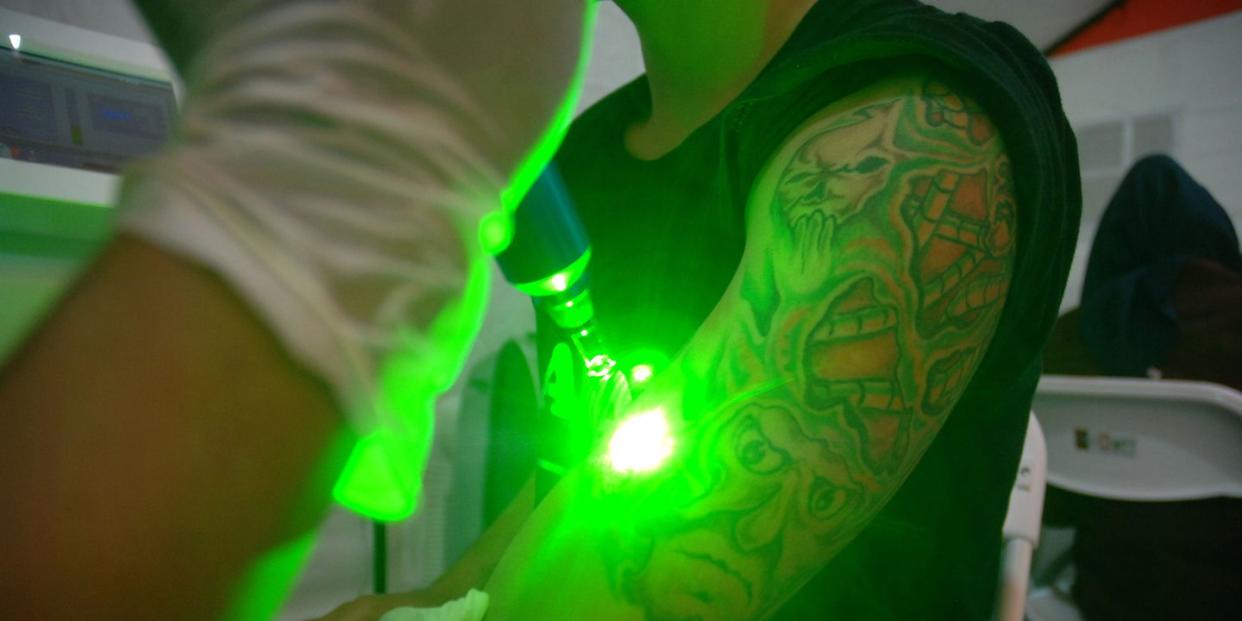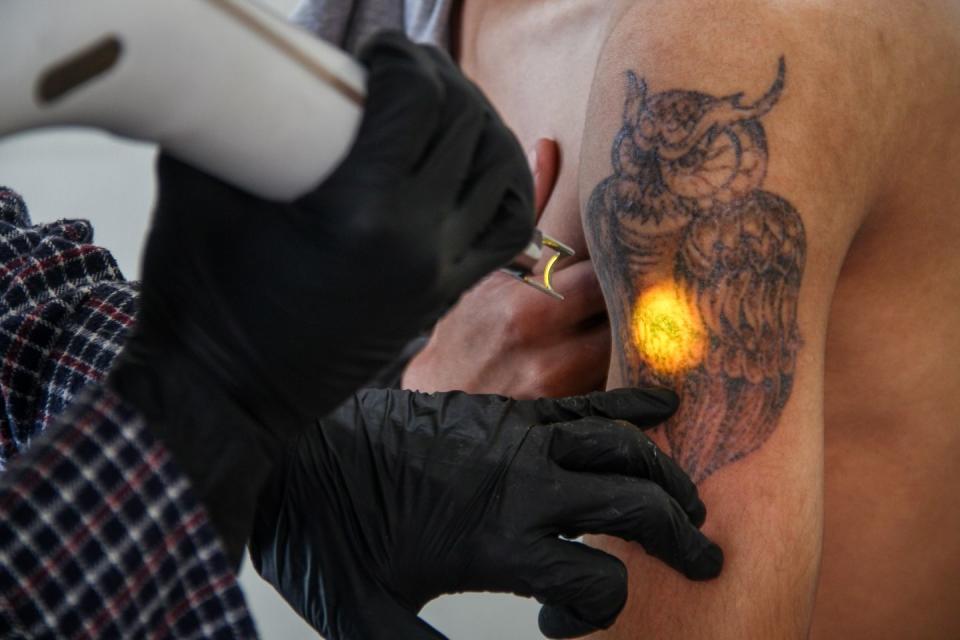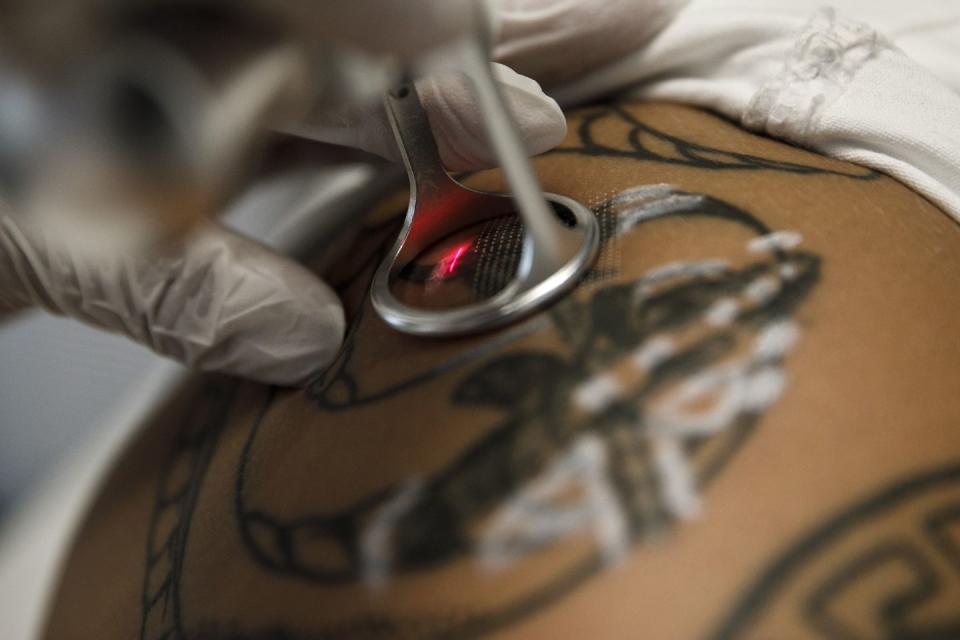What You Need to Know About Laser Tattoo Removal Before Going Under the Beam

Laser tattoo removal heats the tattoo ink—sometimes to nearly 300 degrees Celsius— to break it apart.
Differing laser wavelengths are often required to take on multiple colors of ink.
New technologies have introduced an array of different types of lasers and pulses.
That tourist-trap tattoo parlor may double as a house of regrets. But if you’ve taken time to rethink the permanence of that ill-advised tattoo choice—whether made in a different state of sobriety, love, or maturity—the science of laser tattoo removal is there to lend a hand.
✅ Science is on our side. We’ll help you make sense of it all—join Pop Mech Pro.
Here’s what you need to know about how laser tattoo removal works before deciding to go under the beam.
How Does Laser Tattoo Removal Work?
The primary method of laser tattoo removal delivers an extremely short pulse of laser energy, Dr. Robert Anolik, a board-certified dermatologist and professor at the NYU School of Medicine, tells Popular Mechanics. A patient’s natural skin tone, tattoo pigment, the laser selected, and method of laser delivery all factor into how the process interacts with ink.
Laser energy from the commonly used Q-switched laser, or the newer picosecond laser, heats the tattoo pigments exponentially, Dr. Anolik says, sometimes reaching up to 300 degrees Celsius. “This leads to a shattering of pigment particles and a release of tattoo pigment from skin cells,” he explains.
Dr. Tina Alster, director of the Washington Institute of Dermatologic Laser Surgery and clinical professor of dermatology at Georgetown University, tells Popular Mechanics that the laser light energy converts into heat within the targeted tattoo ink. This photo-acoustic reaction “literally blasts the pigment and causes it to disappear,” she says.
The American Society of Plastic Surgeons says the normal human immune system typically removes small foreign particles from the skin, but original tattoo ink particles are too big; the use of lasers breaks up the particles into smaller pieces. Lasers can heat pigment-containing cells quickly through short pulses to rupture them and send the fragments into the body for drainage.
Where does all that ink go? Some of the tattoo pigment gets washed away by the body’s natural lymphatic system and some is released through the healing skin surface post-treatment.
When Is Laser Tattoo Removal Most Effective?

Dr. Anolik says targeting darker pigments—think black and blue—on lighter skin tones offers the best chance for a full tattoo removal. “Other factors that make tattoo removal easier are when the tattoos are older and if they are performed by amateurs instead of professional tattoo parlors,” he says. “They are also most effective when the location providing the service has every laser option possible, since some lasers and laser wavelengths are better suited for different skin tones and tattoo pigments.”
Older tattoos are easier to remove because the body has already broken down some of the ink. Many—but not all—laser systems can remove additional colors such as red, yellow, orange, and green, Dr. Alster says, by varying the laser wavelengths.
Cosmetic tattoos, such as lip liner and microbladed eyebrows, are difficult to remove with lasers due to the presence of iron oxide or titanium dioxide, Dr. Alster says. These inks often darken with laser use due to a chemical reaction. In these cases, microneedles or a carbon dioxide laser are the best approach.
How Painful Is Laser Tattoo Removal?
The terms “uncomfortable” or “discomfort” tend to get tossed around when discussing laser tattoo removal. Dr. Anolik says the treatment is most effective and least painful when the patient is comfortable, which is why patients often have lidocaine injected into the skin to make the treatment “smooth and meticulous.”
Some folks say the discomfort is reminiscent of getting the tattoo in the first place. The process has also been described as having a heavy rubber band snapped against the skin repeatedly. Fun.
What to Expect Before and After Laser Tattoo Removal
With tattoo ink dropped below the top layer of the skin, a dermatologist is going to understand the best options for removal. A consultation will not only help you grasp what’s all involved, but can also help the dermatologist determine what tools and materials they will need. At this time, they can even test lasers on your skin.
During an appointment, the skin is often numbed in some manner. Then, the pulsating laser goes to work, sometimes using various lasers at different wavelengths to break up the multiple pigment colors. Plus, you’ll need to wear protective eyewear.

Following a treatment, the skin may suffer from swelling, blisters, or bleeding. The area may even be an open wound and will need to be treated as such. And expect to come back. It often takes multiple visits—the larger the tattoo, the more treatment necessary—to fully remove a tattoo, if full removal is even possible.
The tattoo was originally created by layering ink, so plan on the removal to also require the layer-by-layer removal of ink, leaving time in between treatments for the body to flush out the broken particles. Many tattoos require five to ten treatments, typically six to eight weeks apart.
Because the ink has dipped too deeply into the skin or the dye color doesn’t respond well to lasers, some tattoos cannot be fully removed.
What Advancements Have There Been in Laser Tattoo Removal?
The science of laser tattoo removal has advanced beyond differing wavelengths to target multiple colors, Dr. Anolik says. Already, dermatologists are starting to use picosecond lasers to deliver laser energy within a shorter pulse duration; typical Q-switched lasers deliver energy within a nanosecond, but the picosecond option can create finer pigment particles.
The integration of fractional resurfacing lasers on occasion can release pigment from the skin surface. And the addition of acoustic wave therapies can act as a complement to laser therapy with sound waves helping lead to “intense tattoo pigment vibration and greater breakdown and release of the pigment during a laser tattoo removal session,” Dr. Anolik says.
Dermatologists are now using the topical solution perfluorodecalin (PFD) in certain situations, which helps wash away some of the water vapor gas that develops immediately after laser treatment. “Once this gas is reduced by the topically placed PFD,” Dr. Anolik says, “we can retreat at the same visit, possibly eliminating more pigment at one visit.”
Is Laser Tattoo Removal Safe?
The American Academy of Dermatology (AAD) believes in the safety of laser tattoo removal. “Most people can safely have laser tattoo removal,” the association writes on an FAQ page, with only a few exceptions existing. The AAD notes that lasers have largely replaced other tattoo-removal methods thanks to the effectiveness of ink removal with fewer treatments and the ability to treat ink colors that were once difficult to remove.
You Might Also Like

